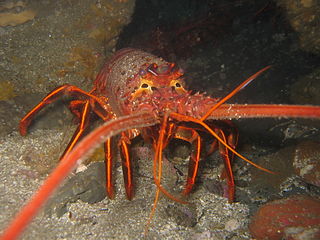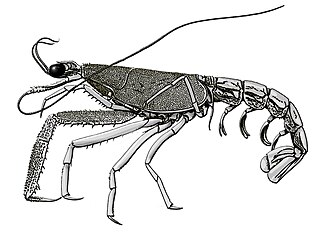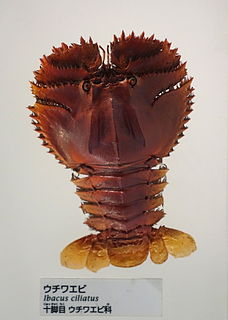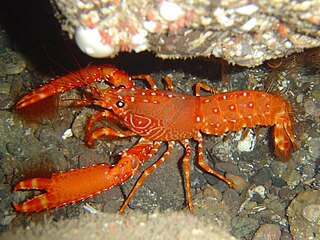
Spiny lobsters, also known as langustas, langouste, or rock lobsters, are a family (Palinuridae) of about 60 species of achelate crustaceans, in the Decapoda Reptantia. Spiny lobsters are also, especially in Australia, New Zealand, Ireland, South Africa, and The Bahamas, called crayfish, sea crayfish, or crawfish, terms which elsewhere are reserved for freshwater crayfish.

The Decapoda or decapods are an order of crustaceans within the class Malacostraca, including many familiar groups, such as crayfish, crabs, lobsters, prawns, and shrimp. Most decapods are scavengers. The order is estimated to contain nearly 15,000 species in around 2,700 genera, with around 3,300 fossil species. Nearly half of these species are crabs, with the shrimp and Anomura including hermit crabs, porcelain crabs, squat lobsters making up the bulk of the remainder. The earliest fossil decapod is the Devonian Palaeopalaemon.

Astacidea is an infraorder of decapod crustaceans including lobsters, crayfish, and their close relatives.

The Cape lobster, Homarinus capensis, is a species of small lobster that lives off the coast of South Africa, from Dassen Island to Haga Haga. Only a few dozen specimens are known, mostly regurgitated by reef-dwelling fish. It lives in rocky reefs, and is thought to lay large eggs that have a short larval phase, or that hatch directly as a juvenile. The species grows to a total length of 10 cm (3.9 in), and resembles a small European or American lobster; it was previously included in the same genus, Homarus, although it is not very closely related to those species, and is now considered to form a separate, monotypic genus – Homarinus. Its closest relatives are the genera Thymops and Thymopides.

Metanephrops challengeri is a species of slim, pink lobster that lives around the coast of New Zealand. It is typically 13–18 cm (5–7 in) long and weighs around 100 g (3.5 oz). The carapace and abdomen are smooth, and adults are white with pink and brown markings and a conspicuous pair of long, slim claws. M. challengeri lives in burrows at depths of 140–640 m (460–2,100 ft) in a variety of sediments. Although individuals can live for up to 15 years, the species shows low fecundity, where small numbers of larvae hatch at an advanced stage.
Metanephrops boschmai, known as the Bight lobster, Bight scampi or Boschma's scampi, is a species of lobster endemic to Western Australia.

Scyllarus arctus is a species of slipper lobster which lives in the Mediterranean Sea and eastern Atlantic Ocean. It is uncommon in British and Irish waters, but a number of English-language vernacular names have been applied, including small European locust lobster, lesser slipper lobster and broad lobster.

Scyllarides latus, the Mediterranean slipper lobster, is a species of slipper lobster found in the Mediterranean Sea and in the eastern Atlantic Ocean. It is edible and highly regarded as food, but is now rare over much of its range due to overfishing. Adults may grow to 1 foot (30 cm) long, are camouflaged, and have no claws. They are nocturnal, emerging from caves and other shelters during the night to feed on molluscs. As well as being eaten by humans, S. latus is also preyed upon by a variety of bony fish. Its closest relative is S. herklotsii, which occurs off the Atlantic coast of West Africa; other species of Scyllarides occur in the western Atlantic Ocean and the Indo-Pacific. The larvae and young animals are largely unknown.

Scyllarides is a genus of slipper lobsters.

Parribacus japonicus, the Japanese mitten lobster, is a species of slipper lobster. Though the common name for this lobster is the Japanese mitten lobster, it is locally called zōri-ebi (ゾウリエビ) – zōri denoting the Japanese sandal it resembles, and ebi meaning shrimp or lobster.
Eunephrops manningi, the banded lobster, is a species of lobster found in the West Indies. It was named in 1974 by carcinologist Lipke Holthuis after his friend and fellow carcinologist Raymond B. Manning.
Scyllarus pygmaeus is a species of slipper lobster that lives in shallow water in the Mediterranean Sea and eastern Atlantic Ocean. It grows to a length of 55 mm (2.2 in), which is too small for it to be fished for. The juvenile form was first described in 1885, with the description of the adult following in 1888 as a result of the Challenger expedition.
Galearctus avulsus is a species of slipper lobster that lives around New Caledonia. It was described in 2011, having previously been included in Galearctus kitanovirosus. It differs from the other species of the genus Galearctus most noticeably in the shape of a groove on the sternum.

Neoglyphea inopinata is a species of glypheoid lobster, a group thought long extinct before Neoglyphea was discovered. It is a lobster-like animal, up to around 15 centimetres (5.9 in) in length, although without claws. It is only known from 17 specimens, caught at two sites – one at the entrance to Manila Bay in the Philippines, and one in the Timor Sea, north of Australia. Due to the small number of specimens available, little is known about the species, but it appears to live up to five years, with a short larval phase. A second species, previously included in Neoglyphea, is now placed in a separate genus, Laurentaeglyphea.

Laurentaeglyphea neocaledonica is a species of glypheoid lobster, and the only species in the genus Laurentaeglyphea. It is known from a single specimen collected on a guyot in the Coral Sea between Australia and New Caledonia. It is thought to be an active predator with colour vision, unlike its nearest living relative, Neoglyphea inopinata.
Thymopides is a genus of deep-water lobsters, comprising the two species Thymopides grobovi and Thymopides laurentae.

Palinurus charlestoni is a species of spiny lobster which is endemic to the waters of Cape Verde. It grows to a total length of 50 cm (20 in) and can be distinguished from other Atlantic species in the genus by the pattern of horizontal bands on its legs. It was discovered by French fishermen in 1963, and has been the subject of small-scale fishery since. It is thought to be overexploited, and is listed as Near Threatened on the IUCN Red List.
Nephropides caribaeus is a species of lobster, the only species in the genus Nephropides. It is found in western parts of the Caribbean Sea, from Belize to Colombia. It grows to a total length of around 170 mm (6.7 in), and is covered in conspicuous tubercles.

Ibacus ciliatus is a species of slipper lobster from the north-west Pacific Ocean.

Enoplometopus antillensis is a species of reef lobster endemic to warmer parts of the Atlantic Ocean. It is found at depths of 5–201 m (16–659 ft) in rocky and coral reefs, where it hides in small crevices. Dwarf reef lobsters are prized in the home aquarium hobby for their bright colors and small size.














